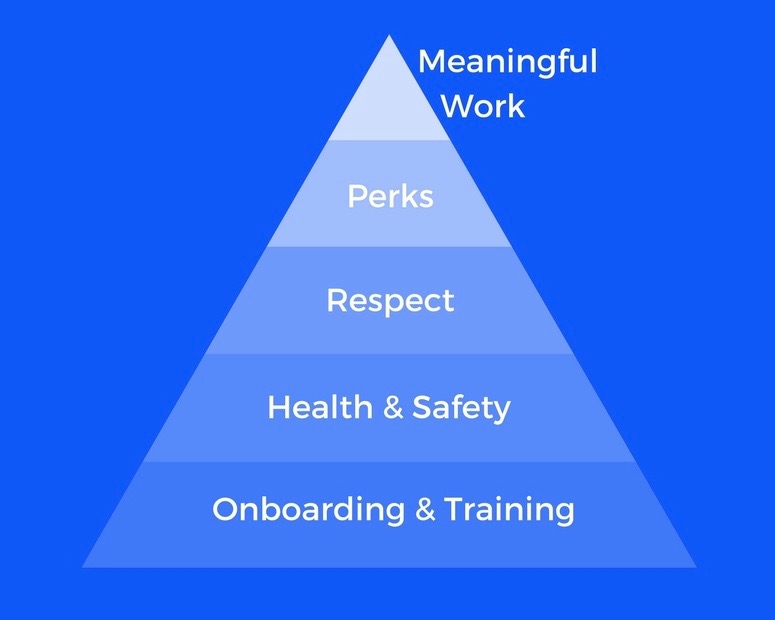
A simple guide to improving workplace engagement by taking care of your employees’ needs.
Food, safety, love, and esteem. These are considered the most basic needs required for humans to survive in society, based on Maslow’s infamous Hierarchy of Needs, developed in 1943. But what about surviving in the modern workplace? Certainly our needs there have evolved in the past 70 years.
From the flexible—yet precarious—schedules of the gig economy (thanks, Uber), to unacceptable management behaviour (Uber again), it’s no longer an unpopular opinion to say that everyone’s workplace needs are changing.
Whereas workers used to expect a fixed job, fixed salary and eight steady hours of work a day, today’s workforce faces a new economic reality. And with that new reality are new workplace needs.
Yes, our jobs help us pay for basic needs like food and shelter. But beyond that, they play an increasingly important role in more personal areas of our lives: our senses of security, accomplishment, and even the pinnacle of self-actualization. It is up to employers to provide the right conditions and environments so that we can achieve our highest potential in these areas and produce outstanding work.
Don’t be fooled into thinking you have to offer over-the-top perks to fulfill your employees’ basic needs. Daily catered breakfasts, on-site barbers and hoverboards are nice, not needed. Put another way, these perks won’t make or break your employees’ ability to do their jobs.
On the other hand, employers shouldn’t confuse business needs with employee needs. It was recently revealed that some of the largest banks in Canada have been putting intense pressure on their employees to meet sales targets. Some employees have even gone so far as to up-sell customers without their knowledge—breaking the law to meet the severe expectations of their workplace.
Employers don’t have to choose between over-the-top perks or driving their employees into the ground. The question is, what should they provide to account for the true needs of their team members today?
Without further ado, here is the new Hierarchy of Needs for the 21st-century worker:
Basic workplace needs
Maslow’s Hierarchy begins with ‘physiological’ needs—the most basic needs that allow each of us to function. In a workplace scenario, these basic needs include:
- A seamless onboarding and training process, ideally with more meaningful introductions and less tedious paperwork.
- Clearly communicated job parameters so employees know what they should be doing and who they report to.
- An employee handbook that details office policies and ground rules .
Before anything else, these small yet important steps go a long way toward achieving the basic needs of your employees.
Workplace health and safety
Workplace health and safety is where your company’s HR department shines the brightest for employee needs.
Employers have a responsibility to provide physically safe working conditions, per Occupational Health & Safety legislation. It is also up to HR to establish an environment where employees feel safe to speak openly about workplace policies and sensitive issues that may come up.
However, safety and security are also closely related to health and wellness. How can we feel secure if our health is suffering or at risk?
Group benefits plans help ensure that employees’ health and wellness (as well as those of their families) are taken care of so they can be their best at work.
Sense of well-being in the workplace
‘Love’ has been removed from Maslow’s original model (be wary of office romance!) to focus on a ‘sense of well-being.’ This relates to cultivating feelings of belonging and respect.
- Hold regular one-on-ones with direct reports to foster open, honest communication about their goals, obstacles, and priorities
- Develop a recognition system to reward a job well done
- Facilitate an environment that values diversity and inclusion
Tools get the job done
As we move further up the pyramid, the needs shift from internal (job and health security) to external—but they are no less important.
Beyond monetary compensation, these types of perks include a comfortable and ergonomic workstation, industry-standard hardware and software, transit passes to help with commuting, and even healthy snack foods to fuel their bodies and minds. These perks may not seem like “needs” at first glance, but with more and more employers offering them, they are becoming necessary in the competition for top talent.
Oh, and since some employees have been accused of wasting money on coffee, why not provide free coffee so they can start saving for retirement instead of splurging on that second latte of the day?
A sense of purpose at the workplace
Maslow’s final level of human needs is ‘self-actualization’–the achievement of one’s full potential. Maslow himself pointed out that this is the highest level of fulfillment and that many individuals never achieve it.
At work, however, there’s no reason we can’t all reach this peak.
Meaningful work means the opportunity to have an impact on the organization, to be a part of something bigger, and continuously seeking challenges and ways to improve. All of these are contributors to an ultimate sense of purpose, fulfillment, and that pinnacle of self-actualization.
As an employer, you can facilitate this by finding the most appropriate role for each employee to keep them engaged at the workplace. How does their job challenge them, excite them, and maximize their potential? Continuous learning and development opportunities
This model of Modern Workplace Needs can serve as a framework for employers who want to increase productivity, receive higher quality work from employees, and create the very best work experience for their teams.

